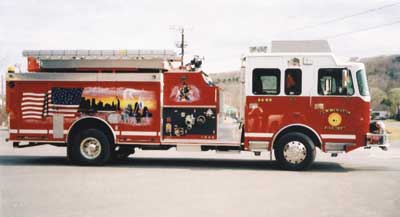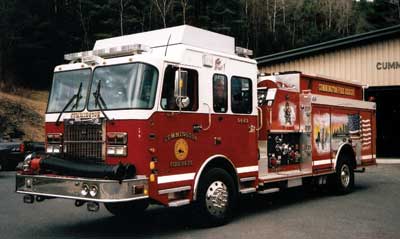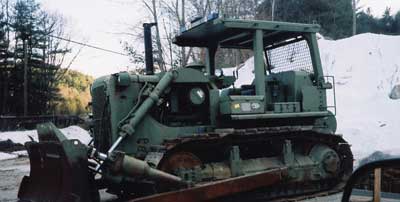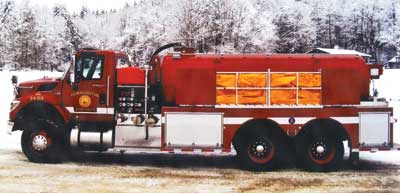By WILLIAM H. WEIGLE
WHEN CHIEF BERNARD L. Forgea took over the Cummington (MA) Volunteer Fire Department (CVFD) in 1982, the department was suffering from a lack of funding and a fleet of obsolete fire engines. He soon realized that his department could not provide adequate fire protection for the 982 inhabitants of his town or the 23 square miles of forests surrounding Cummington.
Forgea, a humble, dedicated, proactive person, brought his lifesaving attitudes, fire safety programs, and desire to correct the dangerous situation “front and center.” Bernie, as he is known, was a combat Marine during the Vietnam War who earned a Silver Star and a Purple Heart for saving fellow Marines during battle. His Marine Corps training as well as his civilian position as a senior emergency response administrator for the Western Massachusetts Electric Company provided him with the leadership skills and foundation to rebuild and overcome the huge financial obstacles, lack of water supply, and poor equipment issues he faced.
Forgea embarked on a multifaceted program to improve things for the CVFD and laid out methods to solve the problems.
1 In 2002, Forgea tapped into a Federal Emergency Management Agency (FEMA) grant program and secured a $350,000 grant, enabling him to purchase a unique 1,500 gallon-per-minute (gpm) custom pumper equipped with compressed air foam, a 1,000-gallon tank, a remote-controlled elevating deck gun, a set of hydraulic rescue tools, four-inch large-diameter hose, and 1¾-inch preconnected attack lines (photos 1, 2). The town of Cummington donated another $100,000 derived from car parking fees from the Cummington Annual Fair and many work details so the department could outfit the pumper. The town also came up with approximately $50,000 for its share of the grants.
 |
| (1, 2) This 1,500-gallon-per-minute custom engine was purchased with a $350,000 FEMA grant and features compressed air foam, a 1,000-gallon water tank, a generator, an elevating deck gun, hydraulic rescue tools, and an elevating light system. Cummington donated an additional $100,000 to fully equip the engine. (Photos by Don Victor unless otherwise noted.) |
 |
2 To provide additional protection for Cummington’s vast forests, Forgea tapped into the United States Department of Agriculture (USDA) Forest Fire Control Program administered by the Massachusetts Department of Conservation and Recreation’s Forest Fire Department, which can obtain federal excess property on a high-priority federal level at no cost. Using this program, Forgea obtained military 2½-ton 1,200-gallon tankers, generators, lighting panels, and bulldozers (photo 3) for use by any mutual-aid fire departments; huge snow blowers; emergency 450-gallon water buffalos; bucket loaders; and heavy-duty diesel dump trucks to aid area fire departments in rescue, flood, ice storm, and hurricane responses.
 |
| (3) An excess property surplus bulldozer equipped with a rear winch for use in forest fires and remediation of roads damaged by Hurricane Irene. It was obtained through the Forest Fire Control Program at no cost. |
3 During this time period, Forgea and nine other small “hill towns” with proactive chiefs joined to form an automatic mutual-aid system using the Massachusetts State Police 911 Communication Dispatch System as well as the Berkshire County Sheriff’s Communication Center and the Franklin County Dispatch Center to dispatch member towns using a carefully thought-out run card program to make good things happen automatically.
4 Six of the member hill towns set up a regional emergency medical service that provides rapid paramedic and emergency medical technician deployment using a new 4 × 4 diesel ambulance donated by a resident who was grateful for the excellent medical service he had received in the past.
5 Staffing shortages sometimes made it difficult to ladder the structures in house and chimney fires in rural areas. To solve the problem, the CVFD purchased a lightly used Altec 60-foot bucket truck equipped with a heavy-duty lifting winch mounted on an International 4 × 4 chassis (photos 4, 5). The department added a 2½-inch hose to the boom, a deluge gun, and a breathing air line; it now had an elevating platform for only $44,000! The platform has been used in chimney fires and ventilation work and was successfully used to lift a victim who had fallen down a long, steep bank near a river.
 |
| (4, 5) This 60-foot Altec 4 × 4 bucket truck features a large 2½-inch nozzle fed by a 2½-inch line, a heavy-duty winch for rescue work, and a breathing air line. This minimizes the need for laddering a roof because of limited personnel. |
 |
6 The next major acquisition was a 3,000-gallon vacuum tanker/pumper with new technology features (photo 6). It is equipped with a Fire-O-Vac vacuum pump that can load the 3,000-gallon tank in 2½ minutes as well as pressurize the discharge of the 3,000 gallons in 2½ minutes using only two firefighters. The unit has drafted from ponds 60 feet away. This tanker/pumper also has a 750-plus-gpm PTO fire pump behind the cab. The unit is mounted on a Navistar IH 7600 severe-duty chassis specifically designed for the fire service; it was purchased for well under $300,000 using a FEMA grant. The town of Cummington paid $14,000 for its share of the grant.
 |
| (6) This Fire-O-Vac 3,000-gallon tanker/pumper features a 750-gpm pump for use as an attack engine. The vacuum tanker portion, with its new technology, can outproduce older model tankers currently in use in gpm using two firefighters only. The price for the vehicle was affordable at less than $300,000. [Photo courtesy of the Cummington (MA) Volunteer Fire Department.] |
7 To successfully improve the Insurance Services Office (ISO) rating from a Class 9 to a Class 9/6, the town undertook the huge project of building a new water system. The CVFD improved its training, dispatching systems, in-house generator, and so on. The addition of the 3,000-gallon Fire-O-Vac vacuum tanker helped the department earn its 9/6 ISO insurance rating.
Forgea’s preplanning, leadership skills, and foresight as well as the tremendous support of his firefighters, his selectmen, the Massachusetts Forest Fire Service, and FEMA have vastly improved the chances of Cummington and the citizens of its nine hill town areas to survive disasters from fire, hurricanes, ice storms, heart attacks, and car crashes.
● WILLIAM H. WEIGLE retired as a volunteer firefighter with the Egremont (MA) Fire Department after more than 40 years of service. He served as an Army Air Corps pilot overseas in World War II and as a surplus screener for federal surplus equipment, obtaining much-needed items for Berkshire County in Massachusetts. Active in community affairs, he helped establish Egremont’s first emergency shelter in 2002. Weigle graduated from Cornell University with a BS degree.
Fire Engineering Archives

